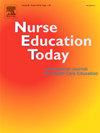Multi-user interactive neonatal resuscitation program using hand tracking in immersive virtual reality: A quasi-experimental design
IF 4.2
2区 医学
Q1 EDUCATION, SCIENTIFIC DISCIPLINES
引用次数: 0
Abstract
Background
Traditional training methods, including lecture-based formats and single-user virtual reality (VR) systems, cannot fully replicate the complexities of team-based emergency care. This study addresses these limitations by utilizing a multi-user VR system with real-time communication and collaboration.
Aim
The purpose of this study was to evaluate the effectiveness of a multi-user interactive neonatal resuscitation program (NRP) utilizing hand-tracking technology in immersive VR and to compare its effectiveness and usability with that of a conventional controller-based single-user VR program.
Design
A quasi-experimental, non-equivalent control group design was used.
Settings
The study was conducted in a VR-based training environment for neonatal resuscitation.
Participants
Participants were divided into three groups: multi-user (MG, n = 34), single-user (SG, n = 27), and control (CG, n = 28).
Methods
The multi-user group used hand-tracking-based immersive VR NRP, the single-user group used controller-based VR NRP, and the control group attended an online lecture. Data were examined using analysis of variance (ANOVA) and post hoc Scheffé tests.
Results
Neonatal resuscitation knowledge (F(2) = 3.01, p = 0.045) and neonatal resuscitation performance confidence (F(2) = 2.87, p = 0.042) were higher in the multi-user group than in the other groups. Satisfaction (F(2) = 3.89, p = 0.024) was higher in the multi-user and single-user groups. Team communication performance (F(2) = 3.21, p = 0.045) and system usability (F(2) = 3.21, p = 0.045) were higher in the multi-user group than in the control group.
Conclusions
Both multi-user and single-user VR training improved learning outcomes, with multi-user environments showing greater improvement in team coordination. Hand tracking was easier to use than controllers, suggesting its potential for enhancing medical education in high-stress scenarios such as neonatal resuscitation.
在沉浸式虚拟现实中使用手部追踪的多用户交互式新生儿复苏程序:准实验设计
传统的培训方法,包括基于讲座的形式和单用户虚拟现实(VR)系统,不能完全复制基于团队的急诊护理的复杂性。本研究通过利用具有实时通信和协作的多用户VR系统来解决这些限制。目的本研究的目的是评估在沉浸式虚拟现实中使用手跟踪技术的多用户交互式新生儿复苏程序(NRP)的有效性,并将其有效性和可用性与传统的基于控制器的单用户虚拟现实程序进行比较。设计采用准实验、非等效对照组设计。本研究是在基于vr的新生儿复苏训练环境中进行的。参与者被分为三组:多用户组(MG, n = 34),单用户组(SG, n = 27)和对照组(CG, n = 28)。方法多用户组使用基于手部追踪的沉浸式VR NRP,单用户组使用基于控制器的VR NRP,对照组参加在线讲座。采用方差分析(ANOVA)和事后scheff检验对数据进行检验。结果多用户组新生儿复苏知识(F(2) = 3.01, p = 0.045)和新生儿复苏表现信心(F(2) = 2.87, p = 0.042)高于其他组。多用户组和单用户组的满意度较高(F(2) = 3.89, p = 0.024)。多用户组的团队沟通绩效(F(2) = 3.21, p = 0.045)和系统可用性(F(2) = 3.21, p = 0.045)均高于对照组。结论多用户和单用户VR训练均能提高学习效果,多用户环境下的团队协作能力提高更大。手部跟踪比控制器更容易使用,这表明它有可能在新生儿复苏等高压力情况下加强医学教育。
本文章由计算机程序翻译,如有差异,请以英文原文为准。
求助全文
约1分钟内获得全文
求助全文
来源期刊

Nurse Education Today
医学-护理
CiteScore
6.90
自引率
12.80%
发文量
349
审稿时长
58 days
期刊介绍:
Nurse Education Today is the leading international journal providing a forum for the publication of high quality original research, review and debate in the discussion of nursing, midwifery and interprofessional health care education, publishing papers which contribute to the advancement of educational theory and pedagogy that support the evidence-based practice for educationalists worldwide. The journal stimulates and values critical scholarly debate on issues that have strategic relevance for leaders of health care education.
The journal publishes the highest quality scholarly contributions reflecting the diversity of people, health and education systems worldwide, by publishing research that employs rigorous methodology as well as by publishing papers that highlight the theoretical underpinnings of education and systems globally. The journal will publish papers that show depth, rigour, originality and high standards of presentation, in particular, work that is original, analytical and constructively critical of both previous work and current initiatives.
Authors are invited to submit original research, systematic and scholarly reviews, and critical papers which will stimulate debate on research, policy, theory or philosophy of nursing and related health care education, and which will meet and develop the journal''s high academic and ethical standards.
 求助内容:
求助内容: 应助结果提醒方式:
应助结果提醒方式:


